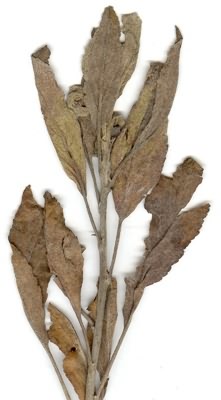Diseases
Podosphaera leucotricha E.S. Salmon - Powdery Mildew of Apple
Systematic position.
Podosphaera leucotricha E.S. Salmon belongs to division Ascomycota, class Ascomycetes, order Erysiphales, family Erysiphaceae.Biological group.
Disease is a biotroph.Morphology and biology.
Powdery Mildew infection may appear on the leaves, buds, shoots, blossoms, and fruit of apple. The mildew fungus over-winters mainly as mycelium in dormant blossom and shoot buds, on dead leaves. In spring, the fungus conidia get on young tissue of plants with the help of the wind. The first symptoms appear most commonly on the lower surface of leaves as whitish lesions consisting of micelium and spores. Lesions may also appear on the upper surface as chlorotic spots. Secondary infection on young leaves results in a fast increase of the infection. At the end of summer and in the beginning of autumn the small black cleistothecia (75-100 microns in diameter) are formed on the affected leaves; the cleistothecia form spores (orbicular or elliptic, 55-70 microns long and 45-50 microns wide), bearing 8 spores in each (20-25 microns long and 12-14 microns wide).Distribution.
Powdery Mildew of Apple is found almost everywhere that apples grow. Development of epiphytoties of Powdery Mildew (one time in 2 years where percent of infection is 50-100%) is observed in the Alma-Ata region of fruit growing in Kazakhstan and in Central Asia, Transcaucasia, in some areas of the Northern Caucasus (in the Krasnodar and Stavropol Territories), in Azerbaijan, Armenia, Latvia, Ukraine and Moldova. The regions where powdery mildew demonstrates a moderate development (one time in 3 years where percent of infection is 30-50%) includes some areas of Kyrgyzstan, Georgia, Transcarpathia, Chechnya and Ingushetia. The lowest degree of disease severity (one time in 5 years where percent of infection is 10-30%) is observed in some regions of the Ukraine, central areas of Chernozem Zone, Baltics, Volga River Region, and also in the Northern Caucasus (Kabardino-Balkaria, Northern Ossetia).Ecology.
Powdery Mildew infections occur when the relative humidity is greater than 90% and the temperature is 10 to 25 degrees C. The optimum temperature range for the fungus is 19-22 degrees C. Temperatures near -20 to -23 degrees C kill a majority of mildew infected buds together with the fungus. Although high relative humidity is required for infection, the spores do not germinate when immersed in water. In spring the spores are produced by the Powdery Mildew fungus that has over-wintered in buds and are carried by winds to vulnerable (young) tissues. Powdery Mildew development is greater in vegetation seasons following mild (warm) winters.Economic significance.
Infected leaves may have a silvery gray color, become stunted and misshapen, being more susceptible to winter frost. The affected raceme of apple does not form fruit, summer falling of infected leaves weakens next year.s fructification. Management of powdery mildew includes the use of plant cultivars, which are less susceptible to the disease, reduction of humidity in the tree canopy by pruning to increase aeration and light and chemical control.Reference citations:
Ablakatova A.A. 1965. Mycoflora and the basic fungal diseases of fruit plants of the south of the Far East. Moscow-Leningrad: Nauka. 146 p. (In Russian)Hawksworth D.L., Kirk P.M., Sutton B.C., Pegler D.N. 1995. Ainsworth & Bisby's Dictionary of the fungi. 8th edition. CAB International. 616 p.
Kobakhidze D.M. 1963. Powdery Mildew of apple. Distribution of pests and diseases of agricultural crops in the USSR in 1962 and the forecast of their appearance in 1963. Leningrad: VIZR. 266 270 p. (In Russian)
Kobakhidze D.M. 1971. Powdery Mildew of apple. Procedure of the territorial many-years forecast of diseases of plants. Leningrad. 28-29 p. (In Russian)
Zherbele I.Ya., Ivanova V.S. 1984. Powdery Mildew of apple in Latvia. Zashchita rastenii. N. 6. Moscow: Kolos. 28-29 p. (In Russian)
© Bilder I.V.


